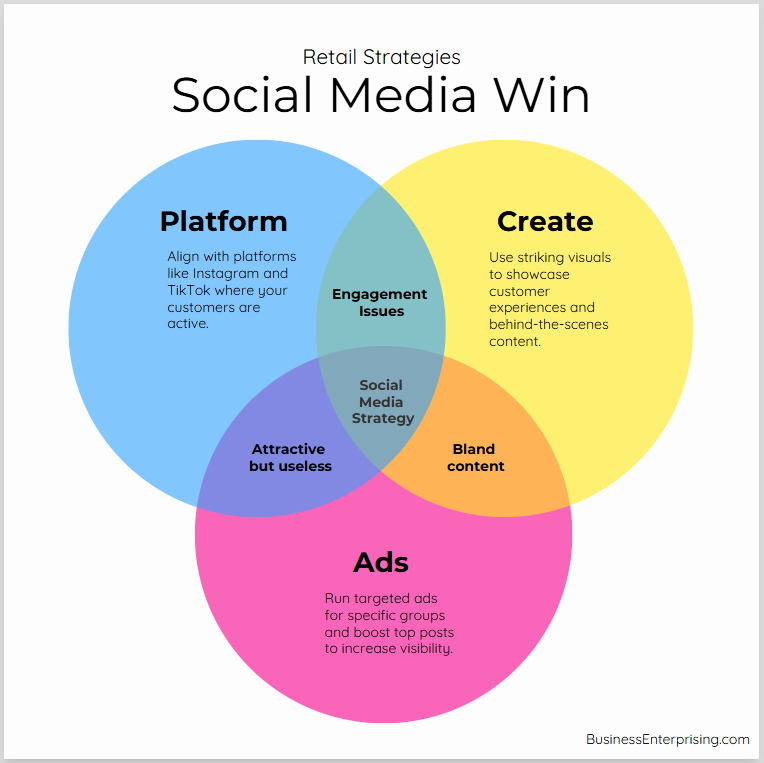
Social media offers a powerful opportunity to build relationships with customers who want to connect with brands on a personal level. Therefore, you should focus on creating posts that provide real value instead of only selling. Additionally, offering a mix of product highlights, customer stories, and helpful tips keeps your content interesting. However, posting randomly without a plan will not bring consistent results.
Retail businesses that succeed with social media usually treat it as a long-term strategy. Therefore, you must stay consistent, even when early results seem slow. Additionally, testing different types of content and adjusting based on feedback helps you grow faster over time. However, ignoring customer comments or feedback can quickly damage your brand reputation.
If you want to use social media effectively, you need to balance creativity with a clear focus on business goals. Therefore, every post, ad, and interaction should move you closer to stronger customer relationships and higher sales. Additionally, building a loyal online community takes daily effort but pays off with steady growth and long-term success.
Choosing the Right Social Media Platforms for Your Retail Business
Choosing the right social media platforms is an important step when building a plan for Social Media for Retail Success. Different platforms attract different audiences and types of engagement. Therefore, you should carefully match your products with the platform that best reaches your target market. Additionally, you need to consider the type of content you can create consistently before making a final decision.
Instagram is an excellent platform for highly visual products like fashion, beauty, and home décor. Therefore, if your products photograph well, Instagram could be a strong choice. Additionally, Instagram Stories and Reels offer quick ways to share new arrivals, promotions, or customer testimonials. However, growing an audience on Instagram requires consistent posting and meaningful engagement.
Facebook works well for retail businesses that want to build community and trust over time. Therefore, you should use Facebook if you want to run targeted ads, build groups, or share longer updates. Additionally, Facebook’s event features are helpful if you run sales, product launches, or pop-up events. However, organic reach can be limited, so pairing posts with ads often brings better results.
TikTok offers a powerful way to reach younger shoppers through creative short videos. Therefore, you should consider TikTok if you sell trend-focused or lifestyle-driven products. Additionally, using trending sounds and hashtags can increase your visibility faster than on more traditional platforms. However, you must keep content fun and casual to perform well.
Pinterest is ideal for products that inspire planning, creativity, or visual discovery. Therefore, you should use Pinterest if your products tie into home, fashion, crafts, or food. Additionally, pins have a much longer shelf life than typical social media posts, making Pinterest valuable for consistent traffic growth.
Creating Engaging Content That Drives Store Traffic and Sales
Creating engaging content is one of the best ways to use social media for retail success. Your content must give people a clear reason to visit your store or website. Therefore, you should focus on showcasing your products in ways that highlight their features and benefits. Additionally, using high-quality images and short videos can quickly capture attention and spark interest.
Product showcases are an easy way to introduce customers to new or popular items. Therefore, you should create posts that show your products in real-world settings whenever possible. Additionally, adding short captions that explain the product’s value helps encourage quick action. However, you should avoid overwhelming your audience with too many sales-focused posts in a row.
Customer stories are another smart way to build trust and encourage conversions. Therefore, you should share testimonials, photos, or videos of happy customers using your products. Additionally, tagging customers who give permission can increase your reach and authenticity. However, always keep the focus on how the product helped the customer rather than on the product itself.
Behind-the-scenes content also helps humanize your brand and build deeper connections. Therefore, you should show how products are made, packed, or prepared for sale. Additionally, introducing your team or sharing day-to-day activities helps customers feel more connected to your business. By mixing product showcases, customer stories, and behind-the-scenes glimpses, you create a content strategy that drives both traffic and sales.
Paid Advertising to Increase Retail Visibility
Leveraging paid advertising is an effective way to boost your results when using social media for retail success. Paid ads allow you to reach more people faster than organic posts alone. Therefore, you should use targeted ads to focus your budget on the shoppers most likely to buy from you. Additionally, creating ads with strong visuals and clear calls-to-action helps drive more qualified clicks.
Promoted posts offer another way to expand your visibility with minimal effort. Therefore, you should boost your best-performing organic posts to reach a wider audience. Additionally, promoting posts can help you test different messages, images, and offers without committing to a full ad campaign. However, you should still target the right audience settings to avoid wasting your budget.
Retargeting strategies are also important when running paid advertising campaigns. Therefore, you should set up ads that show to people who have visited your website or engaged with your posts. Additionally, retargeting keeps your brand top of mind and often leads to higher conversion rates. However, you should refresh your retargeting ads regularly to keep them relevant and engaging.
Paid advertising does not need to be complicated to work well. Therefore, you should start small, track your results, and make adjustments based on what you learn. Additionally, testing different platforms like Facebook, Instagram, and TikTok can help you find the best fit for your store. By using targeted ads, promoted posts, and retargeting, you bring better shoppers to your business.
Building Customer Loyalty Through Social Media Interaction
Building customer loyalty is a major part of using social media for retail success. Real connections with your audience often start with simple interactions. Therefore, you should respond to comments, questions, and messages quickly and personally. Additionally, showing that you value your customers’ input builds trust and keeps them coming back.
Encouraging reviews is another smart way to strengthen loyalty through social media. Therefore, you should ask happy customers to share their experiences after a purchase. Additionally, highlighting positive reviews on your feed or in your stories can motivate others to buy from you. However, you should also handle negative feedback politely and professionally when it appears.
Hosting live sessions gives you a chance to interact with your audience in real time. Therefore, you should consider live Q&A sessions, product demos, or special announcements to keep followers engaged. Additionally, live events allow you to answer questions and showcase your products more personally. However, you must promote your live sessions ahead of time to get good attendance.
Social media loyalty grows through consistent, genuine interactions with your audience. Therefore, you should always make time to thank your followers and celebrate your loyal customers. Additionally, the more personal your interactions feel, the stronger your brand relationships will become. By responding, encouraging reviews, and hosting live sessions, you create a stronger foundation for retail success.
Using Influencer Collaborations and User-Generated Content
Using influencer collaborations and user-generated content plays an important role in building social media for retail success. Influencers can introduce your brand to new audiences in an authentic and trusted way. Therefore, you should partner with influencers who genuinely align with your brand and values. Additionally, working with smaller niche influencers often brings better engagement than focusing only on follower counts.
When choosing influencers, you should look for people who have strong connections with their followers. Therefore, you should prioritize authenticity and engagement over broad reach. Additionally, creating clear agreements about the type of content expected will help your campaigns run smoothly. However, you should give influencers creative freedom to keep the content natural and relatable.
User-generated content is another powerful tool for expanding your brand’s reach. Therefore, you should encourage customers to share photos, videos, and testimonials about your products. Additionally, featuring customer posts on your own channels helps build trust with new audiences. However, you must always get permission before reposting customer content.
Social proof is one of the strongest drivers of new sales on social media. Therefore, you should consistently promote influencer collaborations and user-generated content across your platforms. Additionally, recognizing and celebrating your customers creates a stronger sense of community. By using these strategies thoughtfully, you increase your visibility and make your brand feel more approachable.
Tracking Performance and Adjusting Your Social Media Strategy
Tracking performance and adjusting your strategy is necessary for achieving long-term social media for retail success. Running campaigns without reviewing results can waste time and money. Therefore, you should monitor key metrics regularly to understand what drives real engagement and sales. Additionally, setting clear goals from the start will make your reviews more meaningful.
Engagement rates are one of the first metrics you should check. Therefore, you should track likes, comments, shares, and saves to see which posts resonate best. Additionally, looking at patterns over time helps you decide what content to create more often. However, you should avoid relying only on vanity metrics that do not connect to business results.
Click-through rates offer better insight into how well your posts lead people to your website. Therefore, you should measure how many people click from your social media posts to your product pages or blog. Additionally, testing different headlines, images, and calls-to-action can improve your click-through rates. However, you should avoid making major changes based on small sample sizes.
Sales conversions are the ultimate measure of success for most retail businesses. Therefore, you should connect your social media efforts to actual purchases whenever possible. Additionally, using tracking tools and special promo codes can make measuring conversions easier. By consistently tracking engagement, clicks, and sales, you can fine-tune your social media strategy and improve your results.
Conclusion
Building a strong strategy around social media for retail success takes careful planning and consistent effort. However, when you focus on the right platforms and content, you create real opportunities for growth. Therefore, you should tailor your content to your audience and stay active in your communication. Additionally, using a mix of organic and paid strategies can help you reach even more qualified shoppers.
Social media allows you to build relationships with customers in a way traditional marketing cannot match. Therefore, you should prioritize genuine interactions and community building across every platform you use. Additionally, encouraging user-generated content and influencer collaborations can expand your reach naturally. However, you must stay consistent to see lasting results.
Tracking performance is also key to keeping your strategy strong over time. Therefore, you should monitor engagement, click-throughs, and conversions regularly. Additionally, adjusting your approach based on what works helps you stay ahead of changes in customer behavior. However, you should avoid making assumptions without data to back them up.
Social media continues to be one of the most powerful tools for retail businesses. Therefore, by focusing on engagement, strong content, and ongoing analysis, you put your business in a better position to succeed. Additionally, making small improvements over time can lead to bigger results than you might expect. With focus and persistence, you can turn social media for retail success into a lasting advantage.



